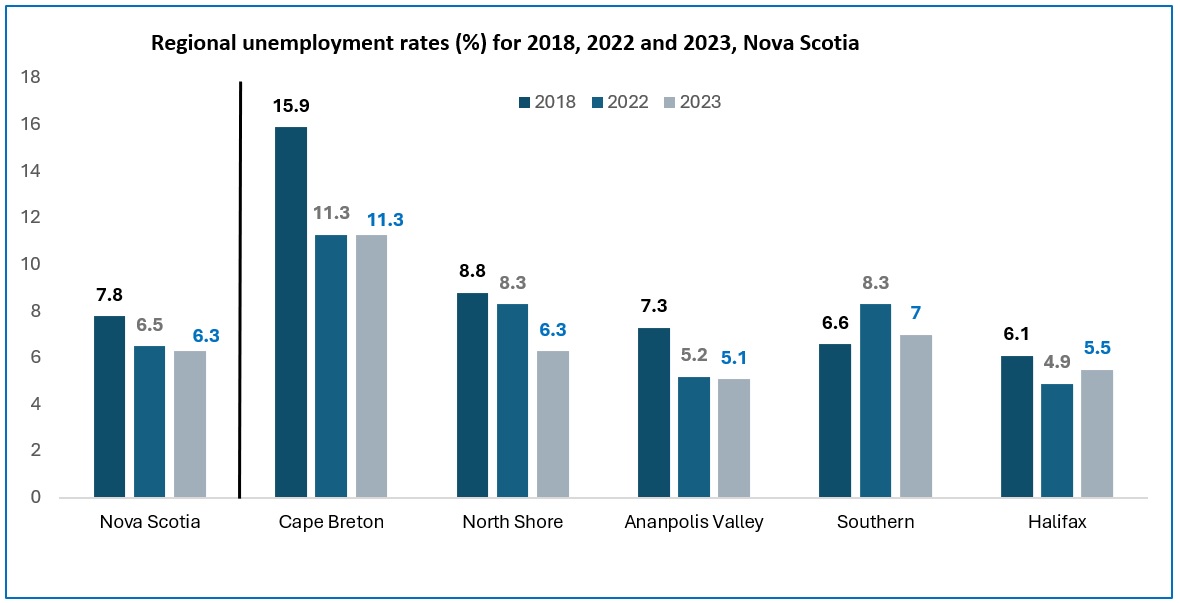Population
Nova Scotia's population started to grow a little in 2016 and 2017 (0.4% and 1.0%) after not growing for many years. In 2023, the population grew even more, reaching over a million people (1,058,694). This was a 3.2% increase from the year before.
This growth happened in all parts of Nova Scotia. Halifax had the most growth. Before 2022, places outside Halifax were losing people, but Halifax kept gaining more people every year for the past 10 years.
In 2023 Halifax accounted for over 50% of provincial population growth, adding 19,237 people.
A closer look at the regions:
- Annapolis Valley gained 2,598 people (1,297 men+ and 1,301 women+),
- North Shore gained 2,201 people (1,065 men+ and 1,136 women+)
- Southern region gained 1,854 people (1,007 men+ and 847 women+)
- Cape Breton gained 7,359 people (3,832 men+ and 3,527 women+)
- Halifax gained 19,237 people (10,396 men+ and 8,841 women+)
Compared to 2019 Nova Scotia’s overall population increased for 82,895 people, which is a growth of 8.5%. Compared to the past 10 years, the population increased by 118,886 people, 12.7%.

Source: Statistics Canada Table 17-10-0152-01 Population estimates, July 1, by census division, 2021 boundaries
Regional Employment
Regional employment was driven by the Halifax region in 2023, while Cape Breton suffered the greatest decline since COVID-19
In 2019, Nova Scotia had strong employment growth. Before the COVID-19 pandemic most regions had positive employment growth except for the Southern region. Employment levels have been influenced by the economic impact of the pandemic and by the declining population in most of the province’s economic regions.
In 2021 the province recovered by +5.6% and then again in 2022 by +3.6%. Employment growth was lower in 2023, at 2.7%.
Here's what happened in each region:
- Halifax: In 2020, employment numbers dropped the least here compared to other regions, down 2.9%. Then, in 2021 and 2022, employment grew (5.4% and 4.8%). But in 2023, the employment growth was a bit slower at 4.4%.
- Annapolis Valley: This area had the biggest employment loss in 2020, down 9.7%, but it bounced back in 2021 and 2022 with growth of 8.1% and 7.4%. However, in 2023, job growth was slower at 1.9%.
- North Shore: In 2021, this region had the largest employment gain at 8.6%. But was the only region to have a decrease in 2022, down 4.2%. This was reversed in 2023 with a growth of 2.9%.
- Cape Breton: In 2021, it was the only region where employment levels dropped, declining by 0.4%. Employment up in 2022 with an increase of 6.7%. Unfortunately, employment went down again in 2023 by 4.8%.
- Southern region: This area had employment growth in 2021 (5.4%) and 2022, though it was just a little in 2022 at 0.8%. And in 2023, there was still some growth at 2.2%.

Source: Statistics Canada Table 14-10-0393-01 Labour force characteristics, annual
Regional Unemployment
Nova Scotia’s unemployment rate in 2023 was the lowest in the past 10 years. All economic regions experienced a steady decline in unemployment rates, including Cape Breton and Halifax.
In 2020, the Nova Scotia unemployment rate peaked at 9.9%. After which, in 2021, it declined to 8.6%, and then further declined to 6.5% in 2022 and 6.3% in 2023.
Here is what is happening regionally:
- Cape Breton had the highest unemployment rate in 2023, but it was the lowest it’s been in 10 years. It stayed the same as 2022 at 11.3%.
- Annapolis Valley had the lowest unemployment rate in 2023, and it was the lowest in 10 years. It is almost two times lower than it was in 2013.
- Halifax had the second lowest unemployment rate in 2023 at 5.5%, and the lowest in 2022 at 4.9%. In 2022, the Halifax unemployment rate was the lowest it has been in the past 10 years.
- Southern region and North Shore had the second highest unemployment rates after Cape Breton – Southern at 7% and North Shore at 6.3%, but they were the lowest rates in 10 years.
 Source: Statistics Canada Table 14-10-0393-01 Labour force characteristics, annual
Source: Statistics Canada Table 14-10-0393-01 Labour force characteristics, annual

Source: Statistics Canada Table 14-10-0393-01 Labour force characteristics, annual